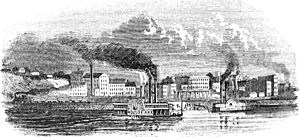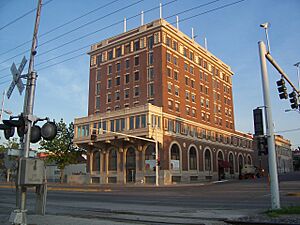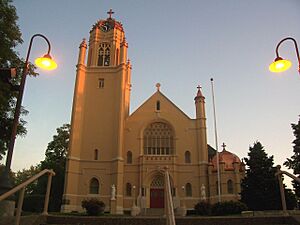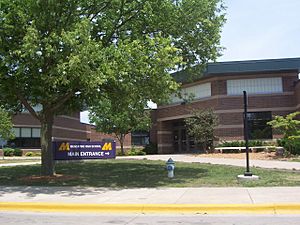Muscatine, Iowa facts for kids
Quick facts for kids
Muscatine, Iowa
|
|
|---|---|

Muscatine County Courthouse
|
|
| Nickname(s):
"The Pearl of the Mississippi", "The Pearl City"
|
|
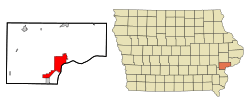
Location in the U.S. state of Iowa
|
|
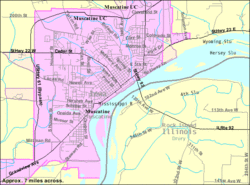 |
|
| Country | |
| State | |
| County | Muscatine |
| Incorporated | 1839 |
| Area | |
| • City | 19.25 sq mi (49.86 km2) |
| • Land | 18.20 sq mi (47.13 km2) |
| • Water | 1.05 sq mi (2.73 km2) |
| Elevation | 587 ft (179 m) |
| Population
(2020)
|
|
| • City | 23,797 |
| • Rank | 22nd in Iowa |
| • Density | 1,307.81/sq mi (504.95/km2) |
| • Metro | 54,741 |
| Time zone | UTC−6 (CST) |
| • Summer (DST) | UTC−5 (CDT) |
| ZIP Code |
52761
|
| Area code(s) | 563 |
| FIPS code | 19-55110 |
| GNIS feature ID | 0465186 |
Muscatine is a city in Iowa, United States. It is the main city of Muscatine County. In 2020, about 23,797 people lived there. The city is located along the Mississippi River. Muscatine is special because no other community in the world shares its name!
Muscatine is the biggest city in the Muscatine Micropolitan Statistical Area. This area includes all of Muscatine and Louisa counties.
Contents
History of Muscatine
Muscatine started as a trading post in 1833. It was set up by people working for Colonel George Davenport. At first, the town was called Bloomington in 1839. But there were many other towns named Bloomington, which caused mail to get mixed up. So, the name was changed to Muscatine. Before that, it was also known as "Newburg" and "Casey's Landing."
The name Muscatine might come from the Mascouten Native American tribe. They lived along the Mississippi River in the 1700s. In 1819, Muscatine Island was called Mascoutin Island. Another idea is that the name comes from Musquakeen, which might be from the Meskwaki people who lived nearby.
Major William Williams visited Muscatine in 1849. He said the town was "one of the most important points in the state." He noted its great location on a bend of the Mississippi River. He also mentioned that it had about 2,000 people, many nice homes, stores, mills, churches, and a courthouse.
From the 1840s until the Civil War, Muscatine had the largest Black community in Iowa. Many were formerly enslaved people who had escaped from the South. Others were free Black people who moved from eastern states. One important leader was Alexander G. Clark Sr.. He was born free in Pennsylvania. He became a successful barber and later a wealthy businessman.
In 1848, Clark helped start the local African Methodist Episcopal Church. This was the first independent Black church in the U.S. He also helped people who had escaped slavery. Before the Civil War, he asked the state government to change unfair laws against Black people. In 1863, Clark helped create Iowa's Black army group, the 60th United States Colored Infantry.
In 1868, Clark fought for equal education. He sued the Muscatine school board because his daughter Susan was not allowed into her local school. He won, and Iowa's public schools became open to all. Later, his son Alexander Jr. became the first Black graduate of the University of Iowa College of Law in 1879. Five years later, Clark Sr. also graduated from law school at age 58. He wanted to be an example for young Black men. Clark became a well-known member of the Republican Party.
In 1890, President Benjamin Harrison made Clark the ambassador to Liberia. Muscatine was special because four of its residents became diplomats between 1855 and 1900. Sadly, Clark died of a fever in Liberia less than a year later. He was buried in Muscatine. His former house was moved in 1975 to make space for a building for senior citizens, which was named after him.
Mark Twain lived in Muscatine for a short time in the summer of 1855. He worked at the Muscatine Journal newspaper, which his brother partly owned.
Twain wrote about Muscatine in his book Life on the Mississippi. He especially remembered the amazing summer sunsets. He said they were like paintings on the wide river, showing every color from soft opal to bright red and purple. He called the Upper Mississippi region "the true Sunset Land."
In 1884, J. F. Boepple, who came from Germany, started a company that made buttons. He made buttons that looked like pearls from the shells of freshwater mussels found in the Mississippi River. This is why Muscatine's slogan is "Pearl of the Mississippi." The McKee Button Company and Weber & Sons Button Co., Inc. made many of these buttons. By 1915, Weber & Sons was the biggest maker of fancy pearl buttons in the world. Muscatine became known as "The Pearl Button Capital of the World." Weber is still making buttons today.
Muscatine is also known as the "Watermelon Capital of the World." This shows how important farming is in the area.
Muscatine was home to minor league baseball teams. The Muscatine Muskies played from 1910 to 1916. Famous baseball player Sam Rice played for the Muscatine Wallopers in 1912.
In 2007, an EF3 tornado hit Muscatine. It caused a lot of damage to parts of the city.
In 2012, Xi Jinping, who later became the President of China, visited Muscatine. He had visited before in 1985 to learn about farming in America.
Geography of Muscatine
Muscatine covers about 18.35 square miles. Most of it is land, and a small part is water.
The city is built on hills and bluffs next to a big bend in the Mississippi River. This bend means the city has about 260 degrees of riverfront. The city's main roads follow these hills and valleys.
Some parts of the city are on "Muscatine Island." This is a flat, sandy area that used to be underwater. The Mississippi River changed its path a long time ago, creating this island. The hills, river, and island all help make Muscatine's economy and neighborhoods diverse.
Muscatine is about 25 miles from the Quad Cities and 38 miles from Iowa City. Many people travel between these cities for work.
Climate
Muscatine has a climate with warm summers and cold winters. It gets rain throughout the year and some snow in winter.
| Climate data for Muscatine, Iowa (1991–2020 normals, extremes 1935–present) | |||||||||||||
|---|---|---|---|---|---|---|---|---|---|---|---|---|---|
| Month | Jan | Feb | Mar | Apr | May | Jun | Jul | Aug | Sep | Oct | Nov | Dec | Year |
| Record high °F (°C) | 69 (21) |
74 (23) |
89 (32) |
93 (34) |
96 (36) |
104 (40) |
111 (44) |
107 (42) |
101 (38) |
96 (36) |
81 (27) |
72 (22) |
111 (44) |
| Mean daily maximum °F (°C) | 31.0 (−0.6) |
35.9 (2.2) |
49.5 (9.7) |
63.1 (17.3) |
73.6 (23.1) |
82.3 (27.9) |
85.4 (29.7) |
83.3 (28.5) |
77.6 (25.3) |
64.5 (18.1) |
49.0 (9.4) |
36.1 (2.3) |
60.9 (16.1) |
| Daily mean °F (°C) | 22.1 (−5.5) |
26.7 (−2.9) |
39.0 (3.9) |
51.2 (10.7) |
62.3 (16.8) |
71.6 (22.0) |
74.8 (23.8) |
72.6 (22.6) |
65.7 (18.7) |
53.2 (11.8) |
39.3 (4.1) |
27.8 (−2.3) |
50.5 (10.3) |
| Mean daily minimum °F (°C) | 13.1 (−10.5) |
17.4 (−8.1) |
28.4 (−2.0) |
39.4 (4.1) |
50.9 (10.5) |
60.8 (16.0) |
64.2 (17.9) |
62.0 (16.7) |
53.7 (12.1) |
41.8 (5.4) |
29.6 (−1.3) |
19.5 (−6.9) |
40.1 (4.5) |
| Record low °F (°C) | −31 (−35) |
−34 (−37) |
−18 (−28) |
10 (−12) |
26 (−3) |
33 (1) |
44 (7) |
39 (4) |
23 (−5) |
17 (−8) |
−5 (−21) |
−23 (−31) |
−34 (−37) |
| Average precipitation inches (mm) | 1.51 (38) |
1.78 (45) |
2.55 (65) |
3.82 (97) |
5.11 (130) |
5.46 (139) |
4.25 (108) |
4.26 (108) |
3.91 (99) |
3.04 (77) |
2.28 (58) |
2.00 (51) |
39.97 (1,015) |
| Average snowfall inches (cm) | 7.0 (18) |
5.8 (15) |
2.8 (7.1) |
0.7 (1.8) |
0.0 (0.0) |
0.0 (0.0) |
0.0 (0.0) |
0.0 (0.0) |
0.0 (0.0) |
0.2 (0.51) |
0.8 (2.0) |
6.2 (16) |
23.5 (60) |
| Average precipitation days (≥ 0.01 in) | 7.7 | 7.8 | 9.1 | 11.3 | 13.4 | 12.4 | 9.2 | 10.1 | 8.4 | 9.8 | 8.2 | 8.6 | 116.0 |
| Average snowy days (≥ 0.1 in) | 4.9 | 3.5 | 1.4 | 0.3 | 0.0 | 0.0 | 0.0 | 0.0 | 0.0 | 0.1 | 0.7 | 3.2 | 14.1 |
| Source: NOAA | |||||||||||||
People of Muscatine
| Historical population | |||
|---|---|---|---|
| Census | Pop. | %± | |
| 1850 | 2,540 | — | |
| 1860 | 5,324 | 109.6% | |
| 1870 | 6,718 | 26.2% | |
| 1880 | 8,295 | 23.5% | |
| 1890 | 11,454 | 38.1% | |
| 1900 | 14,073 | 22.9% | |
| 1910 | 16,178 | 15.0% | |
| 1920 | 16,068 | −0.7% | |
| 1930 | 16,778 | 4.4% | |
| 1940 | 18,286 | 9.0% | |
| 1950 | 19,041 | 4.1% | |
| 1960 | 20,997 | 10.3% | |
| 1970 | 22,405 | 6.7% | |
| 1980 | 23,467 | 4.7% | |
| 1990 | 22,881 | −2.5% | |
| 2000 | 22,697 | −0.8% | |
| 2010 | 22,886 | 0.8% | |
| 2020 | 23,797 | 4.0% | |
| U.S. Decennial Census | |||
In 2020, Muscatine had 23,797 people. Most people were White (77.6%), with 19.1% being Hispanic or Latino. The average age was about 37.9 years old.
Economy and Jobs
Muscatine is home to several important companies. These include Bridgestone Bandag, H. J. Heinz Company, and Bayer. The Kent Corporation, which owns Kent Nutrition Group and Grain Processing Corporation, is also here. Other companies are Musco Lighting and Stanley Consultants.
The HNI Corporation is based in Muscatine. This company designs and makes office furniture like chairs, filing cabinets, and desks. They sell these under different brand names such as The HON Company and Allsteel.
Fun Things to Do
Places to Visit
- The Riverfront: This area has the Pearl City Station, Riverview Center, Riverside Park, and a cool sculpture called "Mississippi Harvest."
- Mark Twain Scenic Overlook: A great spot to see the river, just like Mark Twain did!
- Kent Stein Park: Home to the historic Tom Bruner Field, where baseball used to be played.
- Weed Park and Aquatic Center: A nice park with a swimming area.
- Muscatine Community Stadium and Pearl City Rugby field.
- Muscatine History and Industry Center: Learn about the city's past.
- Muscatine Art Center: Includes the beautiful Musser Mansion and the Stanley Gallery.
- Historic homes: Many old houses from the mid-1800s, like the Weed Mansion and Alexander G. Clark House.
- Two historic districts: Downtown and West Hill are listed on the National Register of Historic Places.
- Discovery Park and Environmental Learning Center.
- St. Mathias Catholic Church.
- Sinnett Octagon House: A unique eight-sided house.
- Pearl Button Museum: Learn about Muscatine's history as the "Pearl Button Capital."
- Former Muscatine North & South Railway Depot: Also known as the Red Brick Building, located by the river.
Schools and Colleges
The Muscatine Community School District serves most of the city. It includes Muscatine High School, whose sports teams are called the Muscatine Muskies. A small part of the city is in the Louisa–Muscatine Community School District.
Muscatine also has Muscatine Community College, home of the MCC Cardinals.
Media and News
The Muscatine Journal is the local newspaper. It comes out every day except Sunday. It started in 1840 and was once partly owned by Mark Twain's brother. Twain even wrote for the paper!
The Voice of Muscatine is another local newspaper that started in 2015.
Radio
Muscatine has two local radio stations: KWPC-AM and KMCS-FM. You can also hear radio stations from nearby cities like the Quad Cities and Iowa City.
Television
Muscatine is part of the Quad Cities TV market. This means you can watch all the local TV channels from that area.
Getting Around
Muscatine is located along two important highways: U.S. Highway 61 and Iowa Highway 92. These highways help people travel for work and connect Muscatine to other cities like Davenport. Iowa Highway 38 connects Muscatine to Interstate 80.
The MuscaBus is the public bus system in Muscatine. It has four routes that help people get around the city. The buses run on weekdays and Saturdays.
Famous People from Muscatine
- Lee Allen, medical artist
- Jack Barlow, country music singer
- Terry Beatty, comic book artist
- Ellis Parker Butler, author
- Roy James Carver, businessman
- Alexander Clark, diplomat and civil rights leader
- Max Allan Collins, crime novelist
- Al Gould, Major League Baseball player
- Scot Halpin, fan who played drums for The Who
- Tom Hearst, NASCAR champion
- Stan Freese, musician and Disney talent director
- Jim Yong Kim, former president of The World Bank
- Sarah Lacina, winner of Survivor: Game Changers
- Hattie Horner Louthan, writer
- Ralph P. Lowe, former governor of Iowa
- Emmett Lynn, actor
- James Bradley Orman, former governor of Colorado
- Dame Margherita Roberti, opera singer
- W. R. Schoemaker, pastor
- C. Maxwell Stanley, engineer
- Phil Vischer, creator of VeggieTales
- Murray Wier, NBA player
- Joe Wieskamp, NBA player
Protecting the Environment
Some companies in Muscatine have worked to reduce pollution. For example, Grain Processing Corp. (GPC) used to release particles and chemicals into the air. They paid a fine and then made big changes. They switched from burning coal to natural gas and built new equipment. These changes have greatly reduced pollution.
Muscatine also has a program called MARRVE (Muscatine Area Resource Recovery for Vehicles and Energy). This program collects food waste and turns it into biogas for vehicles and fertilizer. This helps reduce harmful methane emissions and creates useful products.
Sister Cities
Muscatine has "sister cities" around the world. This means they have special friendly relationships with these cities:
|
See also
 In Spanish: Muscatine para niños
In Spanish: Muscatine para niños


